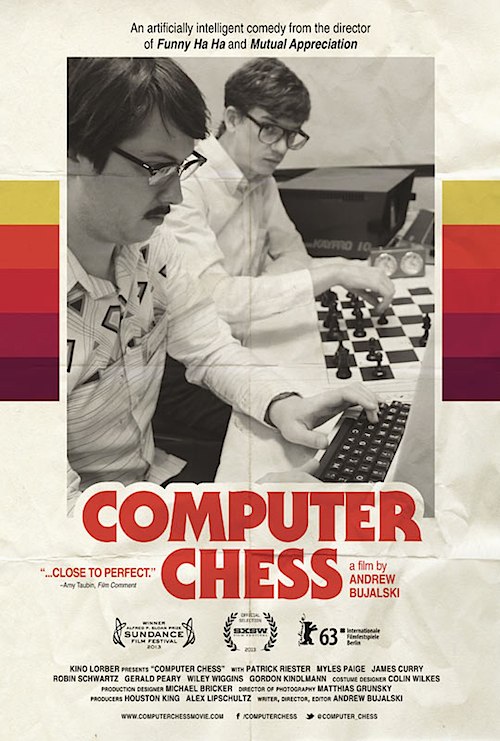By Joe Bendel. In 1980, all music was analog. So was just about everything else. Computers were generally recognized as the coming thing, but they were still too large, bulky, and slow to be a part of most peoples’ daily lives. However, these zero-point-zero generation computers could be programmed to play chess. A motley assortment of early computer pioneers will pit their chess programs against each other in Andrew Bujalski’s retro Computer Chess, which opens this Wednesday at Film Forum.
In a tacky suburban chain motel, some of computer science’s shabbily dressed elite have come together for a computer chess tournament. The winner will face off against the arrogant human host, Pat Henderson, who has never lost a match to a machine—at least not yet. He and his opening night panel predict that will end by 1984, a year rife with significance. The defending champs from Cal Tech are still the presumed favorites, but their TSAR program is acting decidedly buggy. It is so bad, the project director, geek superstar Dr. Tom Schoesser, hastens his arrival for an emergency diagnostic session.
Things seem to be going well for the MIT contingent, with Shelly Flintic receiving an inordinate amount of attention as the first woman team-member in the competition. In contrast, nobody wants to deal with the prickly, borderline homeless Michael Pappageorge, even if he is a mad genius.
 Bujalski fully embraces the technology of the era, shooting Chess in black-and-white, on now archaic late 1970’s video cameras. The film is even rougher and grainier than viewers will expect, yet Bujalski’s nostalgic vision will win them over. Indeed, it is clear throughout the inspired first four-fifths of Chess that the game of chess is really just a stand-in for innumerable AI applications to come. We can also recognize Pappageorge as the sort of social drop-out who either became the Bill Gateses of the world, or more likely remained marginal figures, haunting tech clearance auctions, buying bizarre obsolete hardware to continue building their mad visions.
Bujalski fully embraces the technology of the era, shooting Chess in black-and-white, on now archaic late 1970’s video cameras. The film is even rougher and grainier than viewers will expect, yet Bujalski’s nostalgic vision will win them over. Indeed, it is clear throughout the inspired first four-fifths of Chess that the game of chess is really just a stand-in for innumerable AI applications to come. We can also recognize Pappageorge as the sort of social drop-out who either became the Bill Gateses of the world, or more likely remained marginal figures, haunting tech clearance auctions, buying bizarre obsolete hardware to continue building their mad visions.
Myles Paige arguably deserves award consideration as Pappageorge, finding pathos in his obnoxious behavior. Texas-based film editor Robin Schwartz also gives Chess some soul as Flintic, one of the few competitors with any facility to make human connections. University of Chicago professor Gordon Kindlmann’s Schoesser has a knack for making his theory-heavy dialogue sound smart and accessible, while in his on-screen debut, film critic Gerald Peary chews the scenery nicely as the pompous Henderson.
Considered one of the godfathers of Mumblecore, Bujalski now demonstrates how handy it is to have some plot and an underlying concept supporting a film. Still, he overplays his hand in some respects. Initially, the hippie-dippy encounter group sharing the motel is a rather brilliant piece of era-appropriate cultural satire that could have been lifted from 1980’s uber-zeitgeisty Serial. However, whenever Bujalski contrives ways for the two groups to intersect, the forced comedy falls flat. Likewise, the genre payoffs he offers late in the third act are head-scratchers that make little sense in the film’s overall context.
Frankly, Chess works best when suggesting TSAR might just be the not so distant ancestor of WarGames’ Joshua and 2001’s HAL 9000. Nonetheless, Bujalski presents a consistently compelling time-capsule that captures the innocent fascination and single-minded commitment to innovation that drove the digital revolution. A sly period production with a keen understanding of early computing, Computer Chess is recommended for Wired readers when it opens this Wednesday (7/17) at New York’s Film Forum.
LFM GRADE: B
Posted on July 16th, 2013 at 10:58pm.




